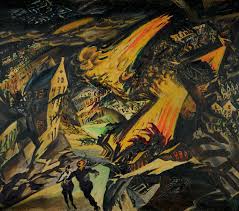
German Expressionism was a bold and emotionally charged art movement that emerged in the early 20th century. It flourished primarily between 1905 and the early 1930s, just before the rise of the Nazi regime. Expressionist artists sought to depict raw emotion, inner turmoil, and the darker aspects of the human experience.
Key groups such as Die Brücke (The Bridge) in Dresden and Der Blaue Reiter (The Blue Rider) in Munich led the movement. Artists like Ernst Ludwig Kirchner, Emil Nolde, Franz Marc, and Wassily Kandinsky rejected academic traditions, embracing distorted forms, vibrant colors, and exaggerated perspectives to evoke strong emotional responses.
Their subjects often included urban scenes, social alienation, and the human figure, reflecting the anxieties of a rapidly modernizing world. Expressionism was not limited to painting; it influenced literature, theater, cinema, and architecture.
The movement was deeply affected by the socio-political upheavals of the time, including World War I and the instability of the Weimar Republic. Expressionist works conveyed a sense of urgency and disillusionment, offering a powerful critique of society.
Although the Nazis labeled their art as “degenerate” and suppressed it, German Expressionism left an indelible mark on global modern art. Today, its influence can be seen in contemporary visual arts, film, and design, continuing to resonate through its daring exploration of the human psyche.